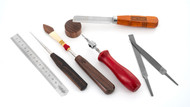Building Your Set of Bassoon Reed Tools
Posted by K.C. Chai, DMA on Jul 13th 2018
Does proper maintenance of the bassoon reed leave you concerned?
This post is aimed at young (perhaps second year) bassoon students, their parents, and those who have not yet learned to make bassoon reeds. The following list of bassoon reed tools includes those I always carry to rehearsals and when teaching private students, just in case of a reed emergency. All of these items are relatively easy to find and come in handy for maintaining your reeds. They will also be used in making your own reeds. I’ll describe the uses briefly here. I am including links to the product category from the Hodge Products website so that you can explore what the items look like and consider any variations or choices that might be available.
Items I always have in my tool bag or bassoon case include the following:
- stub mandrel
- knife
- files
- pliers
- plaque
- sand paper
- cutting block
- clear fingernail polish
- cork grease or beeswax
- 22 gauge brass wire
Reed-adjusting Tools
Mandrels

The mandrel holds the reed while keeping your fingers out of the way of other tools. There are different types of mandrels, some for forming reeds (called forming or long mandrels), which are not what you want at this time. For working on finished reeds, look for a holding mandrel. (Other names include short mandrel, stub mandrel, or working mandrel.) It should have a rounded tip or a dull point. I like the Rieger and Fox brands, though all the other brands at Hodge Products are also of good quality.
Knife

The knife is used for scraping wood off the profile of the reed blades. Look for a knife that is specified for right- or left-handed use. Bassoonists often use double-hollow ground knives for reed blade work, though there are other knife blade designs, like the beveled knife which also works well, but is not suited for the fine detail work at the reed tip. Brands of knives to look for include Landwell, Jende, Rigotti, Chiarugi, Pisoni, Chang, and MusEcho, among others. For purposes of adjusting reeds (as opposed to making reeds), a knife and files are substitutes for each other. It is not necessary at this point to have both.
Files

Files are for smoothing the surface of the reed’s blades or the inside of the tube. I like rat-tail or needle nose files (some companies label them by a measurement), rather than the bigger files used by carpenters and woodworkers. I prefer diamond files over those with tines or teeth (grooves). Files with tines will do fine, though you may also want a steel brush to clean the debris every so often. I use three files: round, rectangle, and triangle, but I recommend only the rectangular file for beginners. For purposes of adjusting reeds, files and a knife can be substitutes for each other. While nice to have, both are not necessary yet.
Pliers

There are specialty reed-making pliers with an oval or hole cut into them which help with forming the tube of a reed. While very useful, they are not strictly necessary at this stage. For tightening and loosening the wires, any set of pliers with grooves or teeth for gripping will be fine. I prefer pliers that are smaller than those often used for auto or workshop use, though some players use big pliers just fine. Hodge Products carries both kinds and most include a wire cutter. Consult with your teacher or a professional to determine if you need specialty double reed pliers.
Plaque

The plaque is placed between the lightly soaked blades of the reed, before knife, file, or sandpaper work is done to the blades. Plaques are made of wood, metal, or plastic, and have a triangular or arrowhead shape. Any material will be fine, but I like the plastic contrabassoon plaque because it is cost-effective and can be used for most bassoon reeds as well as contrabassoon reeds. I also like the plastic plaque because it is easier on the blade of my knife, allowing it to last longer before the knife needs to be sharpened. Double reed shops usually carry a variety of plaques.
Sandpaper

Sandpaper is used for making a fine, smooth finish on the blades, usually after knife or file work. I like grits in the 300 and 400 range, but 240 grit is also usable. Often considered fine-grit sandpaper, wet-and-dry sandpaper is the preference, as it can be used on reeds that are wet or dry, as well as dipping the sandpaper into water (which often makes a smoother finish) before use.
Cutting block

The cutting block is a round piece of wood with a bit of curve on top, used to set the reed tip on when clipping the tip of your reed. It comes in different sizes, sometimes different types of wood and is used with a knife or a razor blade. There are also other clipping options. Consult with your teacher or a professional before trying this to determine when or if clipping your reed might be a good decision.
Other Tools For Your Case or Bag
Cork Grease

Cork grease is for the corks on your bassoon’s tenons or your bocal, when they’re too tight. Beeswax does the same thing for thread-wrapped tenons. Tenons are the part of a joint or bocal that gets inserted into the next piece.
Clear Fingernail Polish

Fingernail polish serves two purposes: to waterproof the thread from the outside, and to re-glue the thread to the tube if it comes loose. Apply clear fingernail polish to the tube under the thread on your reed if it comes totally loose, to glue it in place. If only a little bit of thread comes loose, apply it to that area of the thread. Apply it to the outside of dry thread to seal it against water. In all cases, apply the nail polish very liberally. This extends the life and usefulness of the thread to handle repeated soakings before playing. Colored nail polish will also work, but it will cover up the color of your thread. Allow a few minutes for it to dry.
22 Gauge Brass Wire

22 gauge brass wire can be used to replace a wire on your reed if a wire breaks. It can be found in spools of different weights or sometimes lengths. For carrying in your case or tool bag, cut 3-3.5 inch lengths from a spool, and keep a few pieces with your tools. For more information on choosing your wire gauge, read our Bassoon Wire Gauge blog post.
Tool Bags

Though optional, you or your student may prefer not to have bassoon reed tools loose in your bassoon case. To more easily manage them, there are a number of containment options. One gallon ziploc bags are cheap and easily replaceable if a tool creates a hole. Harder plastic containers, such as Sterilite or Rubbermaid food containers, and pencil or marker boxes are also cost effective choices. Plastic school supply sleeves, such as might fit in a 3-ring binder, may also serve your needs. Vinyl or leather toiletry-size bags are convenient, somewhat organizable, and a bit flexible, and they often have a handle.
Double reed websites also carry roll-up tool pouches, often made of canvas, and wallets made of nylon or leather. These fancy cases offer a high level of tool organization. Almost all of these choices will easily fit into a backpack, but some will even fit inside the bassoon case.
Final Thoughts
Alternatives

One last point to keep in mind is security and safety at your school. If you or your student must walk through metal detectors, some of these tools will be a problem and could be confiscated. In this situation, keep them at home, and take them to your private lessons. Your private teacher can help you or your student learn to use them. But most importantly, let the band teacher know that using these tools is an important part of playing the bassoon. The teacher may be able to make arrangements for the allowance of your tools on school property. It is always best to be honest about having them and why you should be permitted to keep them.
Because both a knife and files could be considered as threatening, an alternative to both is the ReedGeek (see the picture above), including the DoubleGeek. Intended to function like a knife, and at this level like files also, a ReedGeek is considered airplane-safe because it lacks a blade. This detail makes it an excellent choice to carry to school instead of files and a knife as well as for travelling. Though not cheap, the advantages here might more than make up for the extra cost.
There are a few options regarding the ReedGeek, so please explore the link included below. One additional option for diamond files is to use a large size fingernail file, usually available at your large Wal-Mart-type stores, if they're allowed at the school.

